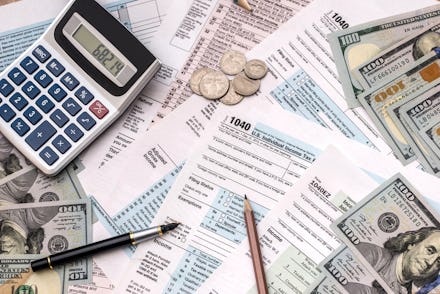Why you should reframe how you think about your tax refund

Filing taxes is up there as one of the most complicated and frustrating obligations of being a law-abiding citizen. The good news is that taxes aren’t as major of a financial burden as we might think, since they fund services we benefit from like public schools and hospitals, and, depending on the way we file our income taxes, we may see a sizable tax refund deposited back into our checking accounts.
As of January 28 this year, Americans were eligible to file their tax returns with refunds coming in as soon as 21 days later. According to statistics from the IRS, the average tax refund during the first week of this year’s filing period clocks in at $1,901, which is $183 or 8.8 percent lower than $2,084 during the same time period the year before, which for some taxpayers came as a surprise and disappointment.
What happened is that, according to Theresa W. Carey, brokerage and investing expert at Investopedia and author of KISS Guide to Online Investing, people felt they were getting more per paycheck because the government recalculated the tax bracket laws, and thus the withholding tables. This means fewer taxes were deducted from paychecks at source and directly remitted to the government. Taxpayers felt as though they were getting less money back because it was already in their pockets.
Dan Ariely, James B. Duke professor of psychology and behavioral economics at Duke University, and chief behavioral economist at Qapital, added that the economy dropped slightly at the end of last year, possibly due to a drop in the number of freelance jobs. On a personal level, he also said the root cause of a lower tax refund could be a job change and decrease in salary. But here’s why it’s not that big of a deal if your refund was lower than expected: “A refund is not free money,” said Carey. “It’s a loan you gave to the government at zero percent interest. What’s more important is your total tax bill, not the size of your refund.”
What next?
Okay, so your refund might not be what you expected. There’s always next year. But in the meantime...
1) Reframe the meaning of a refund
Here’s your chance to rethink what a refund actually means. “Most Americans look forward to tax refunds every year because getting money on April 15 feels like a bonus. But when that tax refunds fails to meet expectations, tax season turns into disappointment and creates uncertainty,” said Ariely. Think of it this way: higher withholdings, which can result in a higher tax refund as in previous years, can benefit your finances in the long run. Ariely said less take-home pay can encourage us to save more, yielding savings equivalent to those of a sizable tax refund.
2) Create your own refund
Relying on the government for a yearly bonus isn’t the greatest way to manage your finances, so create your own refund day. It’s less likely you’ll need a cash bonus right now at the beginning of the year, said Ariely, which makes for the perfect opportunity to refocus your finances and save for upcoming expenses. Put away the type of savings you’d expect or desire from a refund, and instead issue them to yourself when you need the money most, like when you’re paying for summer vacations, back-to-school shopping and holiday gifts towards the end of the year.
3) Get organized
If creating your own tax return sounds too daunting of a task, Ariely said it’s simpler than it sounds. “Research shows many Americans split their refund into thirds, [with] one third towards debt, one third towards spending and one third towards investing,” said Ariely. To save money throughout the year—without having to rely on the boost of a tax refund—you can use a financial app like Mint, BankMobile or Qapital to automatically organize your income into predetermined categories. That way, no matter the size of your refund, you’ll already be on track.